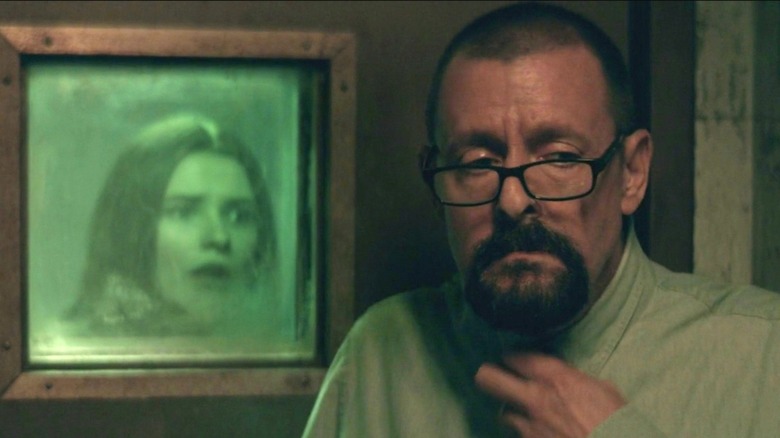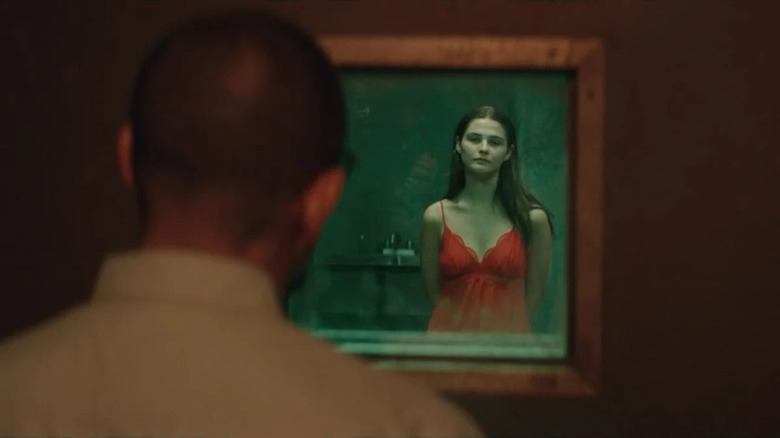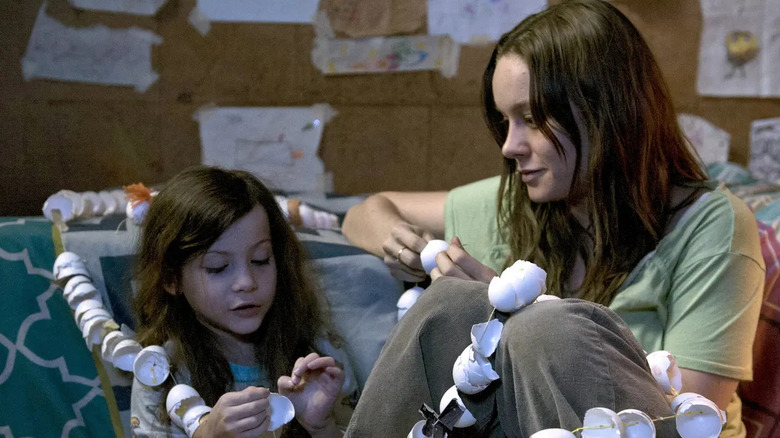Room And Girl In The Basement Share A Horrifying True Story
The Lifetime original "The Girl in the Basement" and A24's "Room" draw from the same harrowing true story. In 2008, a young woman named Elisabeth Fritzl from Amstetten, Lower Austria, escaped the cellar of her family home after being imprisoned for 24 years by her father, Josef Fritzl. During that time, she gave birth to seven of Josef's children — three of whom remained in captivity, one who passed away shortly after childbirth, and three others who were raised by Fritzl and his wife, Rosemarie, as "foundlings" put on their doorstep from their runaway daughter. Josef had told his wife, family, and neighbors that Elisabeth had left town and possibly joined a religious cult.
Elisabeth was able to break free from her underground prison after one of her children became unconscious. Josef took her to the hospital and the doctors were concerned over her poor health conditions. Josef was sentenced to life imprisonment after pleading guilty to suspicion of rape, enslavement, false imprisonment, manslaughter by negligence, and incest. Elisabeth and her children were given new, secret identities and have remained private ever since. "The Girl in the Basement" and "Room" take liberties with this story, some more than others, but both explore these disturbing events of unspeakable trauma.
The Girl in the Basement is too melodramatic
"The Girl in the Basement" changes several parts of the true crime, reducing the young girl's time in confinement from 24 years to two decades and the number of children from seven to four. Elisabeth Fritzl becomes Sarah Cody, a sweet, all-American girl who just wants to be with her first love, Chris, a rugged guy who serenades her with songs and has a motorcycle. Her father, Don, is a tyrannical bully who resents his daughter's newfound independence on her 18th birthday. The filmmakers also add extra tension (because the plot is SO dull...?) by having Sarah attempt to escape twice.
Unfortunately, this adaptation of the Fritzl case is very presentational and does not delve into the character's inner turmoil. The story moves at a breakneck pace, never giving its lead actor Stefanie Scott time to showcase her psychological pain. There is no visible change in her physical performance or makeup to show signs of aging, making the time jumps feel artificial. Our only clue as time passes is when Sarah repeatedly turns to reveal her newly pregnant belly, like a jump scare in a horror film.
Similarly to "Room," Sarah invents a fairy tale story to help her children understand her past and their distressing present. She portrays herself as a fairy princess whose wings have been clipped by her evil father because she loves a prince. At the end of "The Girl in the Basement," her real-life prince Chris shows up on his motorcycle, rescuing her on a ride to their happily ever after. This sentimental ending ignores the difficult realities of Sarah's traumatizing experience and makes romance the main focus — which feels disingenuous in the face of such a life-and-death situation.
Room deeply explores the characters' trauma
"Room" is a more thoughtful and visually sophisticated depiction of Elisabeth Fritzl's story. Emma Donoghue, the author of the novel that inspired the film (which she also wrote), told The Guardian that her original book is only roughly influenced by the Fritzl case:
"I'd say it was triggered by it. The newspaper reports of Felix Fritzl [Elisabeth's son], aged five, emerging into a world he didn't know about, put the idea into my head. That notion of the wide-eyed child emerging into the world like a Martian coming to Earth: it seized me."
The story centers on five-year-old Jack, who has spent his entire young life in an 11x11 shed until his Ma comes up with a plan to escape. His beloved Ma is really Joy Newsome, a teenager who was abducted and has been trapped for seven years. Much of the film is shot from Jack's point of view, whether he's adjusting his eyes to the bright sunlight or staring through the slats of his wardrobe door, trying to make sense of what his captor is doing with Ma. Director Lenny Abrahamson also uses tight framing to immerse the audience in the claustrophobic boredom of the shed. This clashes with the boundless uncertainty and wide open spaces of their eventual freedom.
Donoghue also clarified that despite some of the criticism she received, she was not sensationalizing Elisabeth Fritzl's life: "A lot of people made out I was writing this sinister, money-making book to exploit the grief of victims. I was thinking, it's not like that, but no one will know until they read it." Whereas "The Girl in the Basement" seems to revel in the characters' torture, "Room" actually reflects on the psychological ramifications of such a terrifying experience and the difficulties of assimilating back into society.


